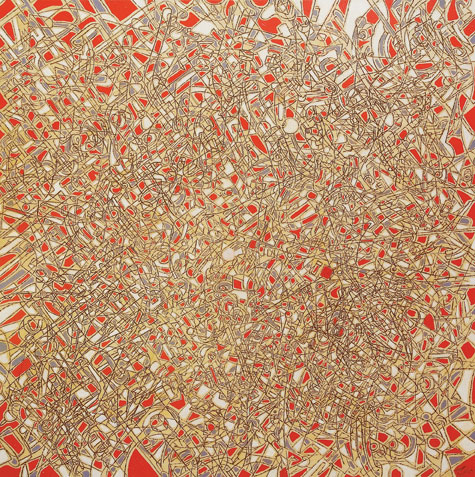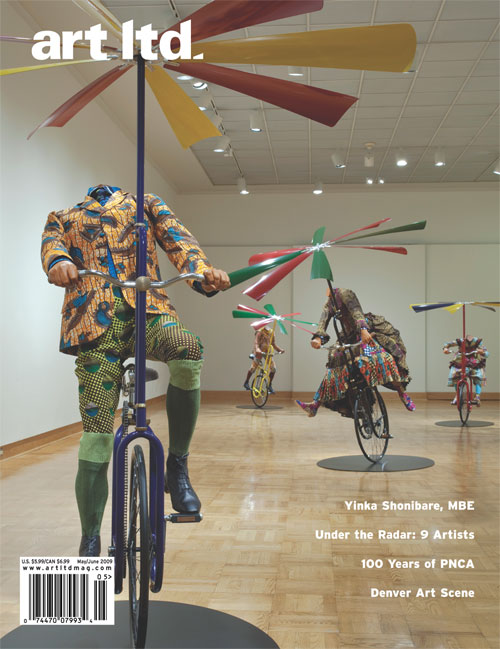May 2009

Transfer Station, 2007, Oil and wood burning
o birch plywood, 53" x 53"
Photo by NessPace, Courtesy of Laura Russo
Gallery
Tom Cramer portrait by Gus Van Sant
Like his artwork, Tom
Cramer is a study in complexity and paradox. He is known for his dazzlingly
intricate wood-relief paintings, his brightly colored murals, which are part of
Portland’s urban landscape, and his glamorous appearance—all sunglasses and
vintage suits—at show openings. But for all his visibility, Cramer also has a
reputation for enigma, reclusiveness, and quirky self-sufficiency. This is a man
who builds his own furniture, grows his own produce, and eschews central heat,
television, and cell phones. Interviewed in his sprawling home, which he has
painted floor to ceiling with dizzying abstract shapes, he comes across genial
and erudite, zipping between ruminations on David Lynch, Alan Watts, Richard
Nixon, and Arthur Schopenhauer in the first five minutes of conversation
alone.
Amidst these flashing tangents, biographical details emerge. A
native Portlander, Cramer was born in 1960 and began drawing at the age of 12.
He was energized by a high school art class with Louis Bunce pupil John Lawrence
and later earned a degree from the Pacific Northwest College of Art and studied
further at Pratt Institute in New York, where he encountered the East Village
art scene at its heady, early-1980s zenith. Back in Oregon, he was commissioned
to paint murals, ballet sets, even motorcycles and cars, in a jaunty mash-up of
graffiti and German Expressionism. He alternated between phantasmagorical
figurative works and a unique semi-abstract mélange of sculpture and painting
that has since become his signature style. In these works, Cramer draws and
painstakingly carves into wooden panels, then paints and glazes in multiple
layers until rivulets of color fill the crannies and gulches between forms. The
relationship between the individual shapes and the larger composition stems from
his fascination with the dynamic between microcosm and macrocosm. Cramer wants
the viewer to shift awareness between these elements, as a means not only to
visual pleasure, but also to a kind of intellectual and spiritual epiphany that
verges on the psychedelic.
A pivotal trip to India in 1998, which he
calls “the most impactful four weeks of my life,” filled the artist with new
ideas. He began incorporating more curvilinear, mandala-like forms, fastidiously
carving and re-carving the shapes with the aid of double-magnification jeweler’s
goggles and customized tools and sharpeners from Europe. He also began
overlaying selected pieces with gleaming gold, silver, and copper leaf, yielding
an opulence that evokes the gilded Buddhas of India and Thailand. More recently,
Cramer has incorporated pyrography into his repertoire in a series of painted
wood-burnings that pop and jostle with bold colors and rhythms. Across his
output, he is intent on marrying the works’ broad conceptual overtones with the
sensuality of their craft-intensive execution.
Cramer’s working method is
monomaniacal and hermetic. “I can’t work with any interruptions or anybody
around,” he says, “kind of like Jack Torrance in The Shining. Sometimes
I’ll go into my shop around 1 pm and work solid till 5:30 the next morning.” He
describes his process as a trance-like state, in which fastidious pre-drawings
give way to improvisational riffs. With their lush vegetal imagery harkening to
an Easternized reimagining of Art Nouveau, his large-scale panels can take as
much as 450 hours of drawing, painting, carving, re-carving, glazing and gilding
to complete. It is as if the artist, intent on pulling out every available stop
to achieve his material and thematic ends, will not be satisfied unless the
viewer experiences full-blown sensory overload and psychic revelation. “What I’m
trying to do,” he says, “is to use the maximum amount of elements I can get away
with, and stopping just short of the whole thing falling apart.”
Tom
Cramer’s newest work will be shown this fall, from October 1-31, 2009, at Laura
Russo Gallery, Portland, OR

